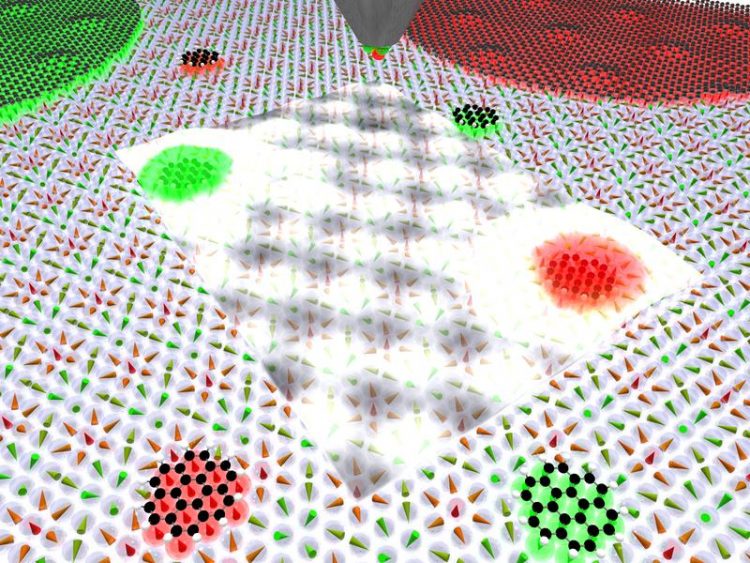Molecular magnets swirl together

An illustration of molecular magnets embedded in a skyrmion lattice. J. Brede, research group of Prof. R. Wiesendanger, University of Hamburg
On the quest for novel solutions for future information technology, scientists from the University of Hamburg and the Forschungszentrum Jülich managed to couple molecular magnets through a lattice of magnetic skyrmions – a whirl in the magnetization of special materials – and to transfer digital infor-mation over large distances. Using the magnetization to store and transfer information outperforms current electronic components due to greatly reduced power consumption while largely enhancing processing speed.
The innovations in information technology are still happening at a tearing pace but in particular in the mobile sector conventional semiconductor technology will reach its limits soon. Therefore the quest for novel and efficient methods to store, transport, and manipulate data at an ultimately small scale is cur-rently a vibrant field of research.
A particularly promising approach is the field of “nano-spintronics”, where the “spin” rather than the charge of the electron is utilized. In a simplified picture the spin of the electron can be understood as the rotation of the electron about its axis. In 2011, physicists from Hamburg University demonstrated a spintronic-logic gate built up of individual magnetic atoms and nano-islands. However, a severe limitation of the realized logic gate was the operating temperature close to absolute zero (-273°C).
Consequently, a way to realize more stable structures capable of operation at higher temperatures was searched for. A promising template was the magnetic skyrmion lattice which was discovered in Hamburg in 2011. The magnetic skyrmions can be pictured as whirls in a “sea” of atomic magnets; the skyrmion magnetization “swirls” by 360° from the edge to the center.
The blessing of the skyrmion lattice – its inherent stability against external perturbations – is also its curse, how to utilize such a robust structure for information processing?
To overcome this obstacle the scientists deposited cost-efficient and readily prepared organic molecules on an iron film of one atomic layer thickness on an iridium substrate. The molecules bond the underlying iron atoms together to form well-defined molecular magnets which are embedded within the skyrmion lattice.
In the figure shown below, the digital information contained within the molecular magnets – the magnetization points either up (red=1) or down (green=0) – is visualized and another advantage of the fabrication method becomes apparent: it is possible to tailor magnets by choosing the appropriate size of the organic molecule, i.e. “larger” molecules make stronger magnets.
While the approach to employ cost-efficient molecules to create tailored magnets holds promise for ap-plication in data storage in itself it is another observation that fascinated the physicists in particular. The scientists noticed that the molecular magnets could be coupled through the skyrmion lattice: When one of the molecular magnets was flipped by applying an external magnetic field, another molecular magnet, situated several nanometers away, flipped as well, the information “swirling” through the skyrmion lat-tice.
Utilizing this method information can be transferred over long distances save, fast, and energy-efficient since there is no need for a flow of electrons. Extending this approach further and coupling multiple mo-lecular magnets in appropriate ways, more complex structures such as ultra-small logic-gates can be envi-sioned.
Another benefit of using the magnetization for computation is the non-volatile nature of the in-formation which becomes clear after restarting a device: it is possible to continue right where one left off. The long and tedious process of booting the electronic device becomes obsolete.
Original publication:
Long-range magnetic coupling between nanoscale organic–metal hybrids mediated by a nanoskyrmion lattice
J. Brede, N. Atodiresei, V. Caciuc, M. Bazarnik, A. Al-Zubi, S. Blügel, and R. Wiesendanger,
Nature Nanotechology (2014) .
DOI: 10.1038/nnano.2014.235
Additional Information:
Prof. Dr. Roland Wiesendanger
Sonderforschungsbereich 668
Universität Hamburg
Jungiusstr. 11a, 20355 Hamburg
Tel.: (0 40) 4 28 38 – 52 44
Fax: (0 40) 4 28 38 – 24 09
E-Mail: wiesendanger@physnet.uni-hamburg.de
Media Contact
All latest news from the category: Physics and Astronomy
This area deals with the fundamental laws and building blocks of nature and how they interact, the properties and the behavior of matter, and research into space and time and their structures.
innovations-report provides in-depth reports and articles on subjects such as astrophysics, laser technologies, nuclear, quantum, particle and solid-state physics, nanotechnologies, planetary research and findings (Mars, Venus) and developments related to the Hubble Telescope.
Newest articles

A universal framework for spatial biology
SpatialData is a freely accessible tool to unify and integrate data from different omics technologies accounting for spatial information, which can provide holistic insights into health and disease. Biological processes…

How complex biological processes arise
A $20 million grant from the U.S. National Science Foundation (NSF) will support the establishment and operation of the National Synthesis Center for Emergence in the Molecular and Cellular Sciences (NCEMS) at…

Airborne single-photon lidar system achieves high-resolution 3D imaging
Compact, low-power system opens doors for photon-efficient drone and satellite-based environmental monitoring and mapping. Researchers have developed a compact and lightweight single-photon airborne lidar system that can acquire high-resolution 3D…





















